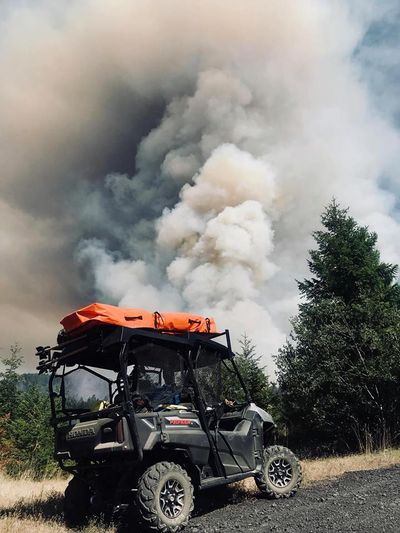County Fire District 9 outfits vehicle to respond in difficult terrain

Spokane County Fire District 9 has created a new type of first response vehicle for backcountry wildfires that has been in hot demand so far this summer.
The district purchased a quad utility task vehicle and outfitted it with climbing and medical equipment in addition to a backboard and Stokes basket, which are used to haul injured firefighters out of danger and to more advanced medical treatment. The Rapid Extraction Module is staffed by four people, including two firefighters trained in technical rescue and at least one paramedic.
The district created the unit because many of its officers, including Fire Chief Jack Cates, are part of incident management teams that deploy to wildfires around the region.
“We’re part of the commitment to protect the entire Northwest,” said Assistant Chief Doug Bleeker.
Fires are labeled by type, with a Type 1 fire the largest and most serious. The recent Upriver Fire was a Type 3 fire. “That’s locally a very significant fire,” Bleeker said.
As fires burn in remote areas, it becomes more difficult to evacuate injured firefighters and get them to medical care in the “golden hour” when treatment is most effective, Bleeker said: “Incident managers are getting more and more concerned about that.”
Cates often serves as a safety officer on Type 2 fires, Bleeker said. The terrain and difficulty of getting an injured firefighter out often determines how the fire is fought, he said. Crews not only have to worry about the fire itself, but also falling trees, heat and even bees and wasps disturbed by the fire.
“It’s an inherently dangerous job,” Bleeker said. “It’s not a leisurely backpack trip. You’re hauling heavy equipment and fighting a fire.”
The REM was created to help combat that danger. “Now they can protect their people and take care of them as they’re getting farther in and in deeper terrain,” he said.
The district has been working on the REM since last year’s fire season. Several weeks ago, Cates was mobilized to the Hendrix Fire in southeastern Oregon. The fire was started by lighting on July 15 and is larger than 1,000 acres, some of that in steep and rugged terrain.
Incident commanders are able to request specialized fire equipment from a list of available equipment. Cates requested the REM, which had just been made available for service. It and four District 9 firefighters have been deployed at the Hendrix Fire ever since.
Other incident commanders have their eye on the REM as well. “There were four other requests for it that quick,” Bleeker said. “Apparently the concept is as useful as we thought.”
The REM has already been used to rescue four firefighters, two for heat-related illness, one with an allergic reaction and one with a minor chainsaw injury, Bleeker said.
Though the equipment and crew belong to District 9, local taxpayers are not paying for it, Bleeker said. The agency that requests the equipment and crew is responsible for paying a daily fee of $500 for the equipment plus the wages of the crew.
The district paid $13,000 for the UTV, but Bleeker said he expects the REM to quickly pay for itself.
“The end goal is that this program be self-sustaining,” he said. “We want it so that the using agencies pay for the cost of this program.”
The REM can stay out indefinitely but the four-man crew rotates out every two or three weeks. Firefighters volunteer to be deployed and in doing so gain valuable experience on large fires that they can use at home when something like the Upriver Drive fire happens, Bleeker said.
“We’re helping out the larger community,” he said. “We make sure we have enough (firefighters) here to take care of what happens here at home.”
If the early interest is any indication, Bleeker expects the REM to continue to be in demand.
“I think if we have the personnel for it, it could stay out all season.”